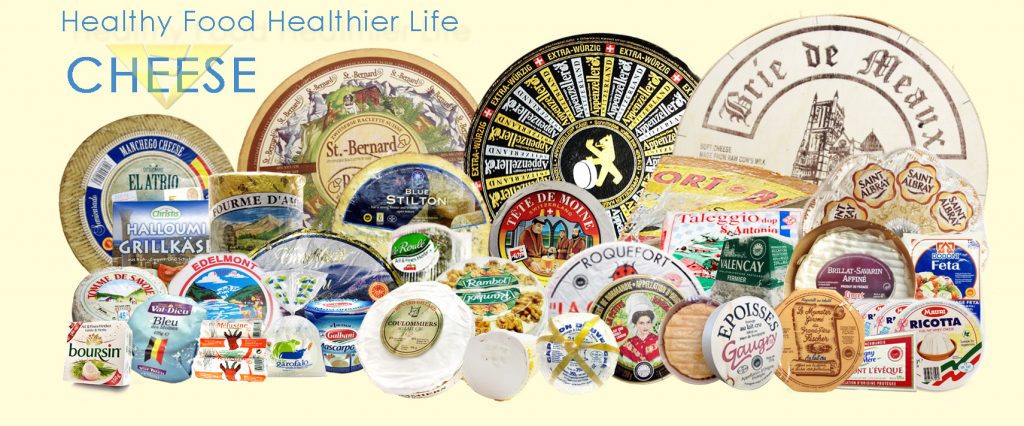Best cheese imported Thailand

Our quality cheese imported are mainly from Europe
VITA FRESH offers a wide range of top quality cheese from many places around the world with the majority from Europe. As you may know, cheese makers originated in either Europe, Central Asia, and the Middle East.
However, the practice had widely spread within Europe prior to Roman times. This is why we emphasizes on importing a variety of European cheeses with the highest quality and moderate prices.
About Our Cheese Imported
SOFT CHEESE IMPORTED FROM EUROPE

The floppy curd is ladled gently into moulds and left to drain in perforated moulds in an atmosphere of high humidity so that the curd does not lose too much whey. After a few hours, the cheeses are turned out of their moulds and left to mature for a few weeks. Their high moisture content, couples with the high humidity, attracts and encourages the growth of the classic white penicillium mould seen on Bries and Camemberts around the world.
The penicillium mould help to break down the curd and contribute to the flavor and texture of the cheese. The result is a creamy, smooth, voluptuous interior that when perfect looks as though it is almost ready to run.
SEMI SOFT CHEESE IMPORTED

To obtain a firmer cheese, the curd is cut up to release some of the whey before the curd is placed in moulds. It is then often lightly pressed to speed up the draining. After a days or so, the cheese is turned out of its mould and washed in brine. This seals the rind before the cheese is placed in cellars or ripening rooms, where other moulds are encouraged to grow. To eliminate the formation of the rind, the cheeses may be sealed in plastic; otherwise the moulds that form are frequently brushed off, gradually building up a leathery rind that may be fine and barely perceptible from the interior, thin orange brown like the rind on raclette or thick grey-brown and leathery like the rind on Tome de Savoie.
Exception: Some semi-soft cheeses are only very lightly pressed and can be eaten within a few days or the cheese may be encouraged to grow a softly be corrupted by the more virulent moulds common to this type of cheese.
WASHED-RIND CHEESE IMPORTED

The curd, which may or may not be cut depending on how soft the final cheese should be, is scooped into moulds and left to drain. The high moisture of the curd and the humidity of maturing rooms attracts a bitter – tasting, grey, hairy mould called “cat fur “. To discourage this, the newly formed cheese is rubbed with or dunked in baths of salty water, wine or a similar alcoholic liquid. This produces a rather robust cheese and encourage the development of orange, sticky bacteria that help to break down the curd from the outside, gradually becoming an integral part of the interior, rather than just a skin.
HARD CHEESE IMPORTED THAILAND

To make a hard cheese the curd must be cut more finely – from small cubes to rice size pieces – the smaller the pieces, the more whey will be lost from the curd. The curds are then gently heated in a vat to force out more moisture before the whey is drained off. Salt is then added to the curds, which now resemble rubbery, lumpy, cottage cheese. They may be cut again (the process differs for various types of hard cheeses) before being placed in large perforated moulds that are frequently engraved with a unique symbol, logo, pattern or name to identify the finished cheese or its maker.
FRESH CHEESE IMPORTED

The milk is warmed, the starter culture is added and the acidity starts to increase. For some cheeses, like fromage frais, the starter is sufficient. These are called Lactic Cheese. Most cheese, however, require the addition of rennet. This is stirred into the milk, then left for a few hours until it coagulates and resembles a very floppy milk jelly freshcheese. The amount of moisture remaining with the whey will determine how soft or hard the final cheese will be.
Fresh cheeses are high in moisture. The young curd is carefully placed in sacks or small perforate containers and drained slowly without pressure for a few hours so that the curd retains much of the whey. Once sufficient whey has been drained off, the curds are either mixed or sprinkled with salt. They are now ready to be eaten. Some fresh cheeses are allowed to mature and grow either a white or bluish grey mould, which places them in a different category.
BLUE CHEESE IMPORTED FROM EUROPE

Blue cheese are neither pressed nor cooked. Most frequently the curd is crumbled, eliminating much of the whey, then scooped into stainless steel cylindrical moulds, each with a wooden disk on the top. The curd remains in the moulds for 1-2 weeks and is turned frequently to let the weight of the curds press out more of the whey. Once the cheese can stand up on their own, they are removed from the moulds, rubbed with salt, then returned to the cellars.
For more details,
Line@, wechat, facebook, linkedin, email or call to us follow the contact below
Other products / สินค้าอื่นๆ
VITA FRESH FINEST IMPORTED PRODUCTS SINCE 1980
- Cheese imported ชีสนำเข้า1 product
- Chef Hat by PAL หมวกเชฟ2 products
- Dried Fruits ผลไม้แห้ง นำเข้า5 products
- Fillo & Kataifi Pastry2 products
- Fresh Berries เบอร์รี่สดนำเข้า2 products
- Frozen Vegetable & Berries1 product
- Groceries14 products
- Herb Dried สมุนไพรแห้ง นำเข้า16 products
- Nut Bean Seed Imported15 products
- Spice Dried เครื่องเทศนำเข้า18 products


